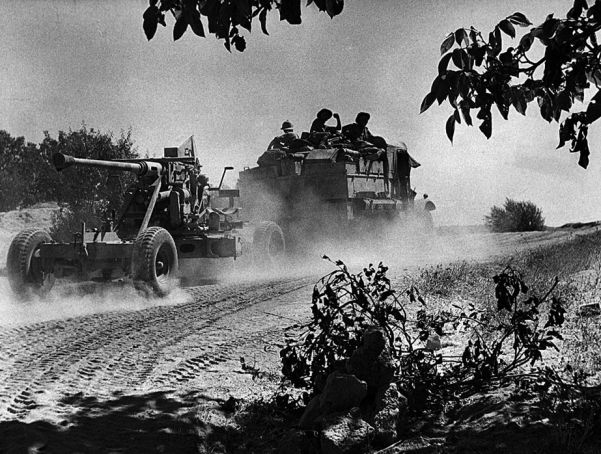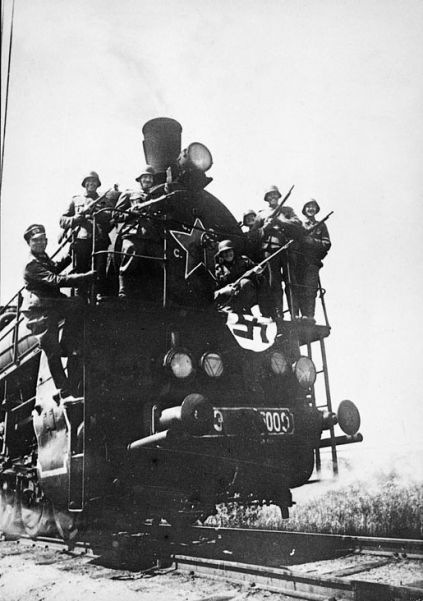8-21 June
Middle East, Syria

An Allied force of 20,000 Free French, British, and Commonwealth troops, under General Sir Henry M. Wilson, invades Syria from Palestine and Iraq amid fears of increasing German influence in the country. They face 45,000 Vichy French troops under General Henri Dentz, plus naval forces that engage the Allies on the 9th.
In subsequent days the Allies encircle enemy units and use heavy artillery to overcome resistance. Vichy forces abandon the capital, Damascus, to the Allies on the 21st.
13 June
Final Solution, Vichy France
Over 12,000 Jews have been ‘interned’ in concentration camps after being accused of disrupting relations between Vichy France and Germany. The Vichy authorities are increasingly persecuting Jews and passing legislation to deny them property rights.
15-17 June
Africa, Libya
General Sir Archibald Wavell launches Operation Battleaxe to relieve Tobruk and break the German hold on Cyrenaica. An armored and infantry division crosses the Egyptian-Libyan border around Halfaya Pass, Fort Capuzzo, and Hafid Ridge. The new British tanks brought to strengthen the 7th Armored Division have suffered mechanical problems and their crews have had inadequate training. The understrength Allied divisions suffer heavily against the experienced German armor and antitank guns. Wavell halts Operation Battleaxe after losing 90 of his 190 tanks.
17 June
Politics, Germany
Adolf Hitler decides to launch Operation Barbarossa, the invasion of the Soviet Union, on June 22. He has an extreme hatred of the Slav people and the communism that rules them. Hitler aims to enslave the ‘inferior’ Slav peoples, exploit their resources, and occupy their lands as part of his Lebensraum (‘living space’) policy for the Aryan race.
22 June
Eastern Front, Soviet Union

Germany launches Operation Barbarossa, the invasion of the Soviet Union, with three million men divided into three army groups along a 2000-mile (3200-km) Front. Hitler aims to achieve a speedy victory to destroy the Red Army before the summer ends and the Soviets can mobilize their immense resources. Army Group North, under Field Marshal Wilhelm Ritter von Leeb, strikes toward the Baltic and Leningrad. Army Group Center, under Field Marshal Fedor von Bock, aims to take Smolensk and then Moscow, and destroy communications. Army Group South, under General Gerd von Rundstedt, advances toward the Ukraine and the Caucasus.
Soviet forces are caught by surprise and lose a series of battles along the Frontier. German air attacks quickly destroy 1800 Soviet aircraft on the ground. German forces make rapid progress in the north and center but meet stiffening resistance in the south.
26-29 June
Politics, Finland
Finland declares war on the Soviet Union and launches an attack on the 29th. The Finns aim to recapture the territory lost to the Soviets during the Russo-Finnish War. When they finally achieve this objective, Adolf Hitler asks Marshal Karl von Mannerheim, the Finnish leader, to help Germany besiege Leningrad, but he refuses.
26-30 June
Eastern Front, Soviet Union
The fortress at Brest-Litovsk is taken after fierce resistance, while the important crossing of the Bug River by Army Group Center begins on the 26th. This group’s initial objective is Minsk. The fast-moving panzers encircle Red Army units at Bialystok, Novogrudok, and Volkovysk, leaving them open to destruction by follow-on infantry forces. Unimaginative Soviet linear defensive tactics and weak divisions are proving vulnerable to rapid German panzer advances, especially on the flanks. In addition, Germany’s total aerial superiority has led to heavy Red Army losses.
27 June
Politics, Hungary
The government declares war on the Soviet Union.
29 June
Politics, Soviet Union
Joseph Stalin assumes control of the federation’s Defense Ministry and appoints a five-man council of defense.
